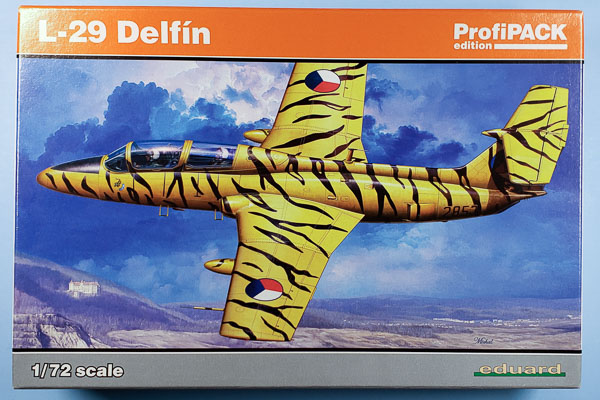
Eduard 1/72 L-29 Delfin Profipack
By Chris Banyai-Riepl
Overview
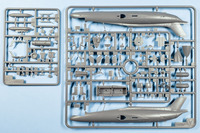 The need for jet trainers was a requirement around the world in the 1950s, and as a result a whole slew of different types arose. In the United States there was the T-33, in France there was the Fouga Magister, and in Czechoslovakia was the L-29 Delfin. In all three cases, these trainers found their way into multiple air forces and examples of each can still be seen flying today. For the L-29, while designed in Czechoslovakia, it quickly drew the attention of the Soviet Union and while it was not the perfect choice, it was reliable and had stable flight characteristics, making it a solid trainer. Because of those stable flying characteristics, the L-29 was also used in combat in a ground support role in Africa and the Middle East.
The need for jet trainers was a requirement around the world in the 1950s, and as a result a whole slew of different types arose. In the United States there was the T-33, in France there was the Fouga Magister, and in Czechoslovakia was the L-29 Delfin. In all three cases, these trainers found their way into multiple air forces and examples of each can still be seen flying today. For the L-29, while designed in Czechoslovakia, it quickly drew the attention of the Soviet Union and while it was not the perfect choice, it was reliable and had stable flight characteristics, making it a solid trainer. Because of those stable flying characteristics, the L-29 was also used in combat in a ground support role in Africa and the Middle East.
The Kit
This kit has been out a few times under other brands, with this being the first time it has come out under the Eduard name. As this is a Profipack release, this kit comes with photoetch and masks, so there will be no shortage of detailing. Starting with the cockpit, this comes with some decent seats out of the box, made up from five plastic pieces. These are made even better with the addition of the photoetch belts and cushions. The instrument panels have raised detailing, as do the sidewalls, but since this is a Profipack you'll have to remove that in order to use the pre-painted photoetch details. There's quite a bit of photoetch for the interior in addition to these details, including a gunsight, the rudder pedals, and various control handles, in addition to fuselage side inserts.
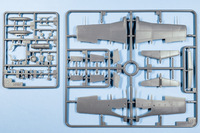 Other interior details include the nose wheel well, which also includes details for the area above the well. There's another piece for the upper fuselage behind the cockpit. The exhaust is made up from four parts that includes a one-piece end cone. With all of the bits and pieces in place, there is no room for nose weight, but the instructions do not include any notes about requiring any. For the exterior of the fuselage, there are some additions for cockpit access steps and intake splitter plates, and there's an aerial for the upper fuselage.
Other interior details include the nose wheel well, which also includes details for the area above the well. There's another piece for the upper fuselage behind the cockpit. The exhaust is made up from four parts that includes a one-piece end cone. With all of the bits and pieces in place, there is no room for nose weight, but the instructions do not include any notes about requiring any. For the exterior of the fuselage, there are some additions for cockpit access steps and intake splitter plates, and there's an aerial for the upper fuselage.
Moving on to the wings, these have separate flaps, and since this a Profipack it includes photoetch for the flap wells. There is also an insert for the intake, and then the wings can be attached to the fuselage. At this point the assembly is down to the last bits, which includes the separate rudder, the stabilizer with a separate elevator, and the landing gear, which includes tires with separate hubs (a nice touch for painting). There are a couple fuel tanks for under the wing, the top to the nose that can be positioned open or closed, and separate air brakes for the rear fuselage. The canopy can be displayed open or closed, and the mask set will make painting that much easier. With all of that done, it's time for the markings.
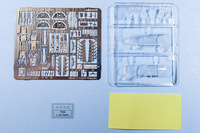 The decals provide five options, with all of them being interesting in their own right. Starting off with easily the most ambitious scheme is the boxtop aircraft, 2853 from 1st Flight, 11th Fighter Regiment, based at Zatec, Czech Republic in 1993. This one is easily the simplest to paint out of all the options, as it is overall yellow. However, any time you save on painting you'll more than lose in decaling, as there are nearly 200 individual decals to apply between the aircraft markings and the tiger stripes. The instructions have some very clear drawings showing what goes where, so the process should go smoothly, but it is definitely a project that should be done over several days just to preserve your sanity. The end result will be worth it, though, as this is definitely a striking scheme.
The decals provide five options, with all of them being interesting in their own right. Starting off with easily the most ambitious scheme is the boxtop aircraft, 2853 from 1st Flight, 11th Fighter Regiment, based at Zatec, Czech Republic in 1993. This one is easily the simplest to paint out of all the options, as it is overall yellow. However, any time you save on painting you'll more than lose in decaling, as there are nearly 200 individual decals to apply between the aircraft markings and the tiger stripes. The instructions have some very clear drawings showing what goes where, so the process should go smoothly, but it is definitely a project that should be done over several days just to preserve your sanity. The end result will be worth it, though, as this is definitely a striking scheme.
The second scheme is 3250 of the International Fighter Pilots Academy at Kosice in the Slovak Republic in 1993. This plane is finished in overall gray with the wings and stabilizer finished in red, white, and blue. The decal options are pretty minimal, with Slovak markings on the wings and vertical tail, text on the left fuselage side, and the IFPA unit emblem on both sides of the nose. The red, white, and blue wings & tail will make this one stand out, not as much as the tiger stripe option, but it's still a colorful option.
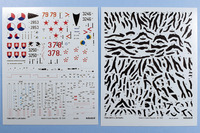 Going back in time a bit, the third option is an operational aircraft, Red 378, from the 101st Fighter Reconnaissance Wing, Szolnok Air Base, Hungary in the summer of 1978. This plane is camouflaged in a three-color scheme on the upper surfaces consisting of a gray green, a red brown, and a dark green, all over a light blue underside. The nose tip is red, and the individual markings include the red 378 on the nose and Hungarian stars on the wings and vertical fin. The instructions note that this plane originally flew in natural metal with the same markings, so if you wanted to do an earlier example in natural metal, you could. The camouflage, though, is an interesting one that would be different from the norm.
Going back in time a bit, the third option is an operational aircraft, Red 378, from the 101st Fighter Reconnaissance Wing, Szolnok Air Base, Hungary in the summer of 1978. This plane is camouflaged in a three-color scheme on the upper surfaces consisting of a gray green, a red brown, and a dark green, all over a light blue underside. The nose tip is red, and the individual markings include the red 378 on the nose and Hungarian stars on the wings and vertical fin. The instructions note that this plane originally flew in natural metal with the same markings, so if you wanted to do an earlier example in natural metal, you could. The camouflage, though, is an interesting one that would be different from the norm.
Option number four is N179EP, a privately owned L-29 of Tactical Air Services seen at Reno in 2009. This plane is finished in a Russian-style camouflage consisting of light gray, medium gray, and blue over light blue and features Russian stars in six positions. The nose has a red 79 and the TacAir name is on the rear fuselage. Tactical Air Services flies two L-29s and uses them for simulating anti-ship or air-to-surface targets during military exercises.
The final option is another Czech one, 3246 from 3rd Flight, 1st Fighter Regiment at Plana Air Base, Czechoslovakia in 1969-70. This L-29 is finished in silver overall with red markings on the outer wing, nose, fin bullet tip, and stabilizer tips. There's also a red band around the rear fuselage. There's a colorful unit emblem on the nose, which is the same emblem found on the unit's MiG-21PFMs. This is a fairly simple scheme compared to the other ones in this release, but to add to the interest to the finished model, this kit includes a thorough set of stenciling. While that adds a lot of time to the decaling process, the end result is worth it as the finished model will look much more like the real thing.
Conclusion
This is a very nice kit of a subject that isn't often seen but has a ton of marking options out there. I'm looking forward to building this one up, just as soon as I figure out which marking option to do. My thanks to Eduard for the review sample.
